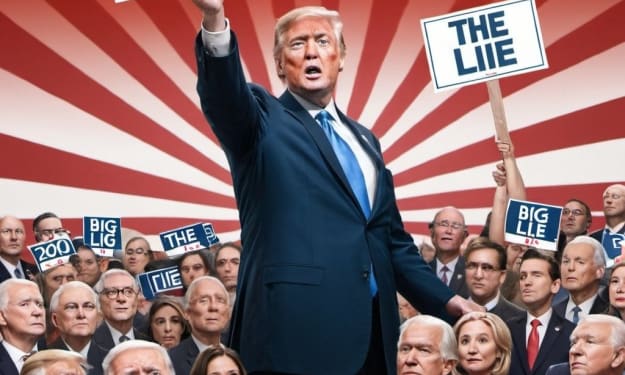The Impact of Misinformation and Propaganda During COVID-19
How False Information Spread and Affected Minds During the Lockdowns

The COVID-19 pandemic was a strange and challenging time for everyone. Suddenly, people were asked to stay inside their homes, away from their friends, family, and daily routines. Schools, offices, and even playgrounds were closed. During this time, many people turned to the internet for information, entertainment, and a way to stay connected. However, not everything on the internet was true or helpful. Misinformation and propaganda spread like a virus and had a significant negative impact on people’s minds.
Misinformation is when false or misleading information is spread, even if the person sharing it doesn’t know it’s wrong. Propaganda is a bit different; it’s information that is biased or misleading, used to promote a particular political cause or point of view. Both misinformation and propaganda can be very harmful, especially during a crisis like the COVID-19 pandemic.
One of the main reasons misinformation spread so quickly during the pandemic was because people were scared and uncertain. When we don’t know what’s going on, we tend to look for answers. Unfortunately, some of the answers people found online were not true. For example, there were many false claims about how the virus spread, how to treat it, and even if it was real. Some people believed drinking bleach could cure COVID-19, which is extremely dangerous and harmful. Others thought that wearing masks was useless or even harmful, despite evidence showing that masks can help prevent the spread of the virus.
These false beliefs led to real-world consequences. People who believed that COVID-19 was a hoax or that masks didn’t work were less likely to follow public health guidelines. This meant that they were more likely to get sick or spread the virus to others. In some cases, misinformation led to people taking harmful actions, like using unproven and dangerous treatments, which caused more harm than good.
Propaganda also played a significant role during the pandemic. Some groups used the crisis to push their own agendas. For example, certain political groups spread false information to make their opponents look bad or to create division among people. They used social media, fake news websites, and even manipulated videos to spread their messages. This kind of propaganda made it harder for people to know what was true and who to trust.
Social media platforms like Facebook, Twitter, and YouTube were major channels for spreading misinformation and propaganda. These platforms use algorithms to show people content they are likely to engage with. Unfortunately, this often means that sensational or shocking information gets more attention, even if it’s not true. When people see the same false information repeatedly, they are more likely to believe it. This phenomenon is known as the “echo chamber effect,” where people are only exposed to information that confirms their existing beliefs.
During the pandemic, many people spent more time on social media than ever before. With more time online and more exposure to false information, it became easier for misinformation and propaganda to take root in people’s minds. This not only affected individuals but also had broader social consequences. Misinformation and propaganda contributed to increased polarization, where people became more divided and less willing to listen to each other. This made it harder for communities to come together and fight the pandemic as a united front.
One particularly harmful piece of misinformation that spread during the pandemic was the idea that vaccines were dangerous or ineffective. Vaccines are one of the most important tools we have to protect ourselves from infectious diseases. However, misinformation about vaccines led some people to believe that they could cause serious side effects or that they were part of a conspiracy. This fear and distrust meant that some people chose not to get vaccinated, which made it harder to achieve herd immunity and control the spread of the virus.
The impact of misinformation and propaganda during the COVID-19 pandemic wasn’t limited to health-related issues. It also affected people’s mental health. Constant exposure to false and alarming information can cause stress, anxiety, and fear. People who were already feeling isolated and worried because of the lockdowns found it even harder to cope when they were bombarded with misinformation. This added stress could lead to feelings of hopelessness and depression, making an already difficult situation even worse.
To combat the spread of misinformation and propaganda, it’s important to develop critical thinking skills. This means learning how to evaluate the information you come across and decide whether it’s true or not. One way to do this is by checking the source of the information. Is it coming from a reputable organization or a random person on social media? Another important step is to look for evidence. Are there studies or experts backing up the claims being made? If something sounds too good to be true or too outrageous, it’s worth taking a closer look to see if it’s real.
Educational initiatives can also help people learn how to recognize and resist misinformation. Schools can teach students how to evaluate sources and understand the difference between reliable information and false claims. Media literacy programs can help people of all ages become more discerning consumers of information.
Social media platforms have a role to play as well. They can work to reduce the spread of misinformation by flagging false content and promoting accurate information from trusted sources. Some platforms have already taken steps in this direction, but there is still more work to be done to ensure that false information doesn’t spread so easily.
The COVID-19 pandemic showed us how dangerous misinformation and propaganda can be, especially when people are scared and looking for answers. It’s important for everyone to be aware of the risks and to take steps to protect themselves and others from false information. By learning to think critically and verifying the information we come across, we can help prevent the spread of misinformation and create a more informed and resilient society.
About the Creator
Enjoyed the story? Support the Creator.
Subscribe for free to receive all their stories in your feed. You could also pledge your support or give them a one-off tip, letting them know you appreciate their work.






Comments
There are no comments for this story
Be the first to respond and start the conversation.